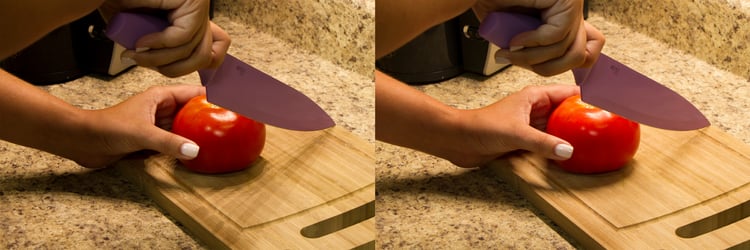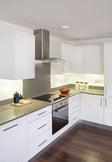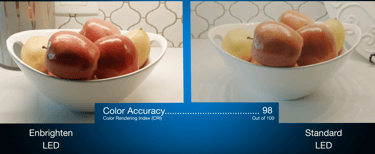In the last article we talked about three important points:Dimmability, Brightness and Color Temperature for choosing LED cabinet light. Let's we learn more about it!
For kitchen lighting, most consumers prefer 2700K – 3000K “warm white,” as many find the bright white intensity of 5000K to be overwhelming in the evening – when you are most likely to be using your kitchen.
Next generation under cabinet light with selectable color temperatures are expected to hit the market in the latter of half 2016, but for the time being, consumers will have to pick a single color temperature and stick with it.
The worst mistake you can make in kitchen lighting is to mismatch the color temperature of your lighting fixtures. If you have 5000K “daylight” LED bulbs in your ceiling fixture and install 3000K “warm white” under cabinet fixtures, your lighting will clash severely if both are turned on at the same time. If you plan to use only one or the other, mismatched color temperatures will be less of a problem, but it is recommended to stick to a single color temperature throughout your kitchen.
Hot Puck light
Lower quality LED under cabinet light tend to use fewer LEDs with wider spacing between each die (light source). The result is an uneven light pattern typified by hot (bright) and cool (dim) spots.
High quality LED under cabinet light use many LEDs, often supplemented with optical diffusion (for example, a diffuser lens), to produce a perfectly uniform light that is free of hot spots. This uniform light also produces only a single shadow.
The difference between a lower quality fixture with hot spots and a higher end product with uniform light distribution may seem subtle, and it is. Most people will not consciously notice or be able to articulate the difference in light quality based on this factor alone; but at an unconscious level, the absence of hot spots will have a big impact on how “clean” the lighting looks and feels in your space.
For kitchen lighting, most consumers prefer 2700K – 3000K “warm white,” as many find the bright white intensity of 5000K to be overwhelming in the evening – when you are most likely to be using your kitchen.
Next generation under cabinet fixtures with selectable color temperatures are expected to hit the market in the latter of half 2016, but for the time being, consumers will have to pick a single color temperature and stick with it.
The worst mistake you can make in kitchen lighting is to mismatch the color temperature of your lighting fixtures. If you have 5000K “daylight” LED bulbs in your ceiling fixture and install 3000K “warm white” under cabinet fixtures, your lighting will clash severely if both are turned on at the same time. If you plan to use only one or the other, mismatched color temperatures will be less of a problem, but it is recommended to stick to a single color temperature throughout your kitchen.
Hot Spots

Multiple shadows from a low quality light with hot spots (left image) vs. only one shadow from the high quality fixture with uniform light distribution (right image).
If usable light to aid with meal preparation is your only goal, then there are many lower cost LED under cabinet light available with moderate hot spotting that will serve you just fine. But if you are looking for a major upgrade to the overall look and feel of your kitchen lighting, consider a mid-market or higher end fixture that provides uniform light distribution free of hot spots.
CRI (Color Rendering Index)
Color rendering index (CRI) is a measurement of color fidelity. In other words, it measures how accurate the color of an object looks under a given light source.
For example, low CRI lighting can make it difficult to distinguish between black and dark navy or brown. For another example, picture your most colorful outfit: now picture it under the fluorescent lighting of an office building (a low CRI of about 60-70). If you were to then walk outside into bright sunlight (the highest possible CRI of 100), the colors would look completely different, with far greater variation and nuance.
Early generation LED products had a relatively low CRI score of about 70. Today the standard is 80, and it is rare to find LED under cabinet fixtures on the market with CRI scores lower than this. Most people are satisfied with 80 CRI, but if you really want to enhance the look of your kitchen, premium fixtures are now available (link to Enbrighten UCF) with CRI scores as high as 98 (nearly perfect).
CRI, while valuable, is an imperfect measurement that can be “gamed” by unscrupulous manufacturers, making it potentially misleading. It is possible for two comparable fixtures from different manufacturers, each with the exact same color temperature and CRI, to produce light that still appears very different when viewed side by side. Discerning consumers should absolutely look for high CRI fixtures, but CRI is only part of the story.
An example of high saturation and high CRI. Enbrighten LEDs vs standard LEDs.
Color Saturation
A more important measurement of how pleasing a light source will be to the naked eye is color saturation. There is not yet a widely adopted measurement for color saturation but LED under cabinet fixtures with high color saturation are typified by high R9 phosphor values. This means the LEDs used in the fixture are “doped” (treated) with a special phosphor additive that enhances the red portion of the color spectrum emitted by that light. The result to the naked eye is that virtually all colors underneath that light will appear more deep, rich, and vibrant.
The best LED under cabinet fixtures will have both a high CRI and high color saturation. When viewed in side-by-side comparison with a standard fixture, the difference in light quality is astounding.
Imagine an old standard definition television and a modern HDTV. The standard definition model looks perfectly nice on its own, but once you see the HD flatscreen in action your standards are forever raised, and you can never go back. Upgrading your kitchen lighting from fluorescent or lower quality LED fixtures to premium LED fixtures with high CRI and high saturation produces similarly extreme results.
Unfortunately, because there is no industry standard way to communicate color saturation to consumers, very few manufacturers pay attention to it, and it is one of the most tragically neglected aspects of residential lighting quality.
Summary
Quality under cabinet light are an effective and affordable way to dramatically enhance the look and feel of your kitchen.
Here are the factors you should consider before purchasing:
-
How long are the cabinets you want to light?
-
How many fixtures will you need, and what lengths?
-
If you will need multiple fixtures, considerable purchasing linkable models that can be powered and controlled from a single source.
-
Do you want plug-in fixtures that can be easily installed and removed or direct wire fixtures that are more complex to install, but can be powered and operated by a single light switch?
-
Select your favorite color temperature (2700K-3000K, or 5000K) and stay consistent with it throughout your kitchen.
-
Is dimmability important to you?
-
Look for fixtures with at least 80 CRI, but 90+ is ideal.
-
For maximum lighting quality that you can see and feel, look for fixtures with high color saturation.
We hope this guide has been informative and useful.




















